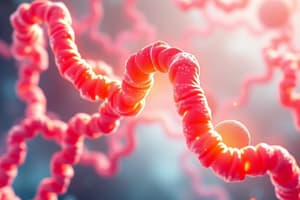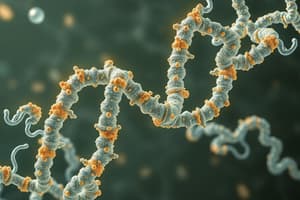Podcast
Questions and Answers
Which of the following statements about peptide bonds is correct?
Which of the following statements about peptide bonds is correct?
- Peptide bonds are always found in the trans conformation. (correct)
- Peptide bonds have resonance structures that contribute to their stability. (correct)
- Peptide bonds are completely flexible and rotate freely.
- Cis configurations of peptide bonds are more common in proteins.
What amino acids are known to disrupt helical structures within proteins?
What amino acids are known to disrupt helical structures within proteins?
- Cysteine and Alanine
- Aspartic acid and Glutamic acid
- Serine and Threonine
- Glycine and Proline (correct)
What characteristic is typical of a β-turn in protein structure?
What characteristic is typical of a β-turn in protein structure?
- It is stabilized solely by covalent bonds.
- It always involves hydrophobic interactions.
- It forms a continuous helical structure.
- It typically involves four amino acids. (correct)
Which non-covalent interaction is primarily responsible for the stability of secondary structures like α-helices and β-sheets?
Which non-covalent interaction is primarily responsible for the stability of secondary structures like α-helices and β-sheets?
What information does a Ramachandran diagram typically convey?
What information does a Ramachandran diagram typically convey?
What type of interaction is primarily responsible for the stabilization of α-helices?
What type of interaction is primarily responsible for the stabilization of α-helices?
Which type of β sheet conformation has greater stability?
Which type of β sheet conformation has greater stability?
What is the diameter range of the outer structure of an α-helix with side chains?
What is the diameter range of the outer structure of an α-helix with side chains?
Which of the following statements about β strands is true?
Which of the following statements about β strands is true?
What determines whether a polypeptide sequence can adopt a stable α-helix or β sheet structure?
What determines whether a polypeptide sequence can adopt a stable α-helix or β sheet structure?
What characterizes the primary structure of a protein?
What characterizes the primary structure of a protein?
Which of the following interactions contribute to the tertiary structure of a protein?
Which of the following interactions contribute to the tertiary structure of a protein?
Why do peptide bonds exhibit partial double bond character?
Why do peptide bonds exhibit partial double bond character?
Which configuration of the peptide bond is more stable?
Which configuration of the peptide bond is more stable?
What primarily drives the folding of proteins into their functional structures?
What primarily drives the folding of proteins into their functional structures?
What is the impact of resonance on peptide bonds?
What is the impact of resonance on peptide bonds?
How are secondary structures defined in proteins?
How are secondary structures defined in proteins?
What is the primary reason less than 1% of peptide bonds involving Pro are in the trans configuration?
What is the primary reason less than 1% of peptide bonds involving Pro are in the trans configuration?
Which amino acid is considered a strong helix former?
Which amino acid is considered a strong helix former?
What is the primary reason proline is considered a helix breaker?
What is the primary reason proline is considered a helix breaker?
What characteristic of glycine limits its incorporation into helices?
What characteristic of glycine limits its incorporation into helices?
What defines a β turn in a polypeptide chain?
What defines a β turn in a polypeptide chain?
In Type I β turns, which amino acid is often found at position AA2 to introduce a kink?
In Type I β turns, which amino acid is often found at position AA2 to introduce a kink?
What is the main difference between Type I and Type II β turns?
What is the main difference between Type I and Type II β turns?
Which amino acid is often found at position AA3 in Type II β turns due to steric hindrance?
Which amino acid is often found at position AA3 in Type II β turns due to steric hindrance?
Which of these structures contributes to the tertiary structure of proteins?
Which of these structures contributes to the tertiary structure of proteins?
What is the main exception to the cis and trans orientation of peptide bonds?
What is the main exception to the cis and trans orientation of peptide bonds?
Which angles are associated with the backbone of a polypeptide chain?
Which angles are associated with the backbone of a polypeptide chain?
What do favorable phi (ϕ) angles minimize?
What do favorable phi (ϕ) angles minimize?
Which feature of the Ramachandran plot indicates favorable or permitted phi and psi angles?
Which feature of the Ramachandran plot indicates favorable or permitted phi and psi angles?
What characterizes the alpha helix structure?
What characterizes the alpha helix structure?
What does the helical wheel represent in alpha helices?
What does the helical wheel represent in alpha helices?
Which of the following secondary structures is characterized by a left-handed twist?
Which of the following secondary structures is characterized by a left-handed twist?
Which of the following is true regarding the peptide bond in proteins?
Which of the following is true regarding the peptide bond in proteins?
Which dihedral angle is associated with the rotation around the Cα-N bond?
Which dihedral angle is associated with the rotation around the Cα-N bond?
Which secondary structure is represented with a characteristic hydrogen bonding pattern and is stable due to these interactions?
Which secondary structure is represented with a characteristic hydrogen bonding pattern and is stable due to these interactions?
Flashcards are hidden until you start studying
Study Notes
Protein Structure Levels
- Primary Structure: Amino acid sequence of a polypeptide chain
- Secondary Structure: Local folding of the polypeptide backbone, forming distinct shapes like alpha helices and beta sheets
- Tertiary Structure: 3D arrangement of an entire polypeptide chain, including the interactions between side chains
- Quaternary Structure: The arrangement of multiple polypeptide chains, forming a protein complex
Peptide Bond Properties
- Peptide bonds have partial double bond character due to resonance, making them rigid and nearly planar
- The trans configuration of the peptide bond is more stable than cis, due to reduced steric clashes between side chains
- Proline is an exception, with a significant proportion of its peptide bonds in the cis configuration
Dihedral Angles
- Phi (φ): Rotation around the N-Cα bond
- Psi (ψ): Rotation around the Cα-C bond
Ramachandran Plot
- Depicts the allowed combinations of phi and psi angles in a polypeptide chain
- Favourable angles are determined by steric clashes and hydrogen bonding interactions
- Allows prediction of secondary structure based on the distribution of phi and psi angles within the plot
Alpha Helix
- Right-handed helical structure with 3.6 amino acids per turn
- Stabilized by hydrogen bonds between the carbonyl oxygen of residue n and the amide hydrogen of residue n+4
- Side chains point outward and downward from the helix
Beta Sheets
- Formed by hydrogen bonding between extended polypeptide segments called beta strands
- Can be parallel (strands run in the same direction) or antiparallel (strands run in opposite directions)
- Antiparallel beta sheets are more stable than parallel due to optimal hydrogen bonding geometry
Turns and Loops
- Connect and stabilize various secondary structures
- Beta turns are the simplest, comprising four amino acids and causing a 180-degree turn in polypeptide direction
- Type I and Type II beta turns differ in the orientation of the carbonyl group of the second amino acid in the turn
- Type II turns often have glycine at position 3 due to reduced steric clashing
Secondary Structure Propensity
- Not all amino acids are equally likely to form alpha helices or beta sheets
- Small hydrophobic residues like alanine favor helix formation
- Proline disrupts both helices and beta sheets due to its rigid cyclic structure
- Glycine is also disfavored in helices because its high flexibility makes incorporation entropically unfavorable
Studying That Suits You
Use AI to generate personalized quizzes and flashcards to suit your learning preferences.




